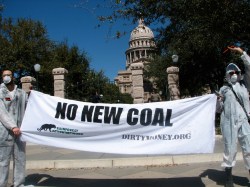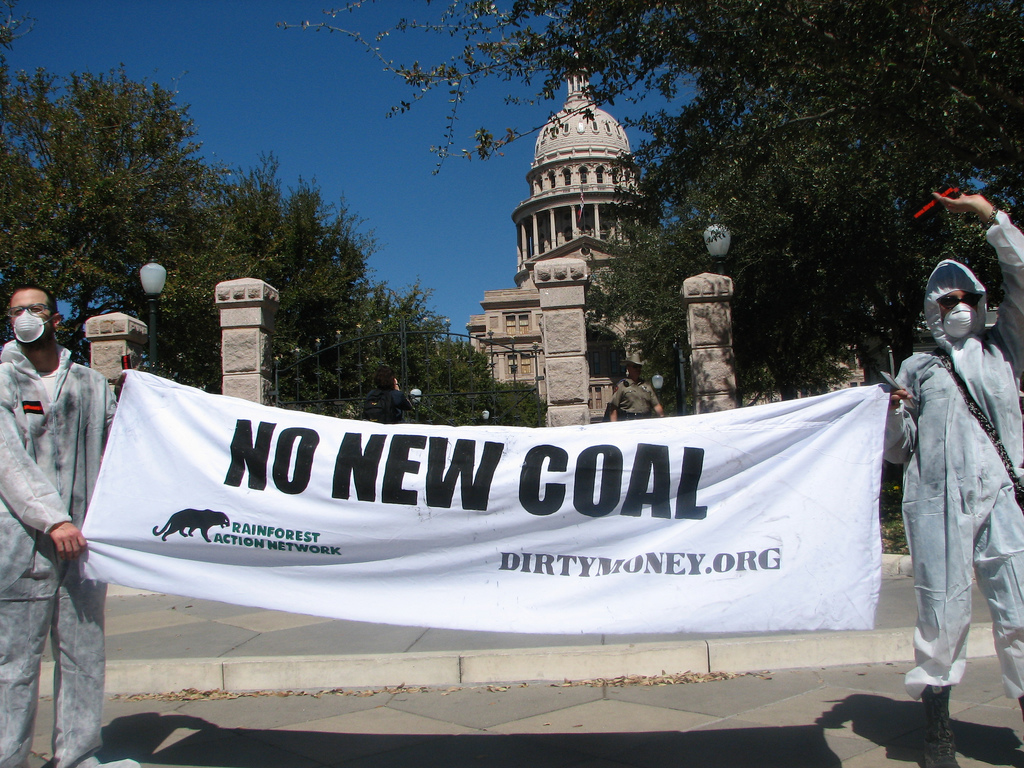It’s a baffle. While reanalyzing the cap-and-trade fight and responding to Theda Skocpol’s controversial paper on it, my esteemed colleagues Bill McKibben, David Roberts, Joe Romm, and Eric Pooley have evidenced some sharp, and sharply worded, differences with one another. But all appear to agree that one big reason cap-and-trade “crashed and burned” on Capitol Hill, as Pooley phrased it, was the lack of public support: If only there had been a vibrant popular movement out in the country demanding serious action on climate change, things might have ended differently. For the record, I suspect this is true (though I also agree with Romm that other key reasons for cap-and-trade’s failure were outside of environmentalists’ control, particularly the 60-vote hurdle in the Senate imposed by filibuster threats from climate change-denying Republicans).

Rainforest Action NetworkActivists in front of the Texas Capitol.
But here’s what I don’t get. There actually was a popular movement out in the country demanding serious action against climate change during Obama’s first term. In fact, this movement was not only demanding action, it was winning it big time. I’m referring to the grassroots movement that helped to prevent the construction of 174 (and counting) new coal-fired power plants, thereby imposing a de facto moratorium on new coal in the United States. Blocking construction of these plants — and therefore of the greenhouse gases they would have emitted over their 40-plus-year life spans — limited future U.S. greenhouse gas emissions almost as much as the cap-and-trade bill would have done. (And this calculation assumes that cap-and-trade would have worked as well as proponents claimed, hardly a sure thing considering how weakened the bill was during congressional horse trading.)
This popular movement called, and still calls, itself “Beyond Coal.” And although it was spearheaded nationally by the Sierra Club, it was populated and led by local and regional activists. Most of these activists hailed from, and kicked ass in, supposedly red states in the South and the Midwest, where most of the battles over proposed coal plants played out. Crucially, this movement was not comprised solely of the usual environmental suspects. Its leaders deliberately reached out more widely, and collaborated as equals with, a range of citizens: farmers who didn’t want coal plants fouling their agricultural vistas, air, and water; doctors and nurses who knew that burning coal kills at least 13,000 Americans every year while causing tens of thousands of additional heart attacks and asthma afflictions; youth who understood that coal is the most carbon-intensive of the conventional fossil fuels and thus is a dire threat to their futures; public officials, some of whom feared the climate impacts of burning coal but all of whom recognized that coal produces the kind of local air pollution that could discourage other businesses from bringing headquarters, jobs, and economic activity to their jurisdictions; and many more.
To be sure — I can hear your rejoinder already, David — the town meetings, lobbying, letter writing, media work, and demonstrations these activists organized were not the sole reason that 174 coal plants ended up not being built; the falling price of natural gas, along with rising energy efficiency and stagnating electricity demand, were key factors as well. But this grassroots opposition clearly played a decisive role, for in the United States decisions about energy are based at least as much on politics as on economics. Referring to the regulatory boards that make the final call in most states on whether to approve or deny proposed power plants, Thomas Sanzillo, a former deputy comptroller of New York state and a consultant to the Beyond Coal campaign, told me, “If the activists hadn’t been there talking to the regulators and [newspaper] editorial boards and making the case that coal was a bad bet, the [utility board] would have gone forward, because the utilities would say, ‘We can handle the costs,’ and the boards are often good-old-boy boards.”
It is not just puzzling but distressing that the Beyond Coal movement and its achievements are so little known, especially among those seeking solutions to the climate crisis. The information is certainly out there. That quote from Sanzillo comes from a long, detailed report on the Beyond Coal movement that I published last April in Mother Jones, a magazine that is by no means unknown within environmental and progressive circles. I’ve also written about Beyond Coal in The Nation, and I think Grist itself has mentioned it once or twice as well. [Editor’s note: Quite a few times, actually.]
Yet the achievements of Beyond Coal continue to go unacknowledged in most climate and environmental discussions of which I’m aware, and I honestly don’t understand why. Is it because mainstream media outlets have (predictably) ignored Beyond Coal — and most environmentalists still implicitly take their cues about what’s true and important from mainstream media? Is it intra-movement jealousy? Is it because Beyond Coal’s victories took place in the states of the South and Midwest rather than on the national stage? Whatever the cause, it is not just baffling but self-defeating for environmentalists to overlook such an important and encouraging political phenomenon. There have been precious few major victories in the fight against climate change, especially within the United States. Surely such victories should be celebrated — and above all learned from — rather than ignored.
OK, you might say, if the Beyond Coal movement was so powerful during the cap-and-trade fight, why didn’t it join the fight? The answer to that question leads, I believe, to one of the key lessons this movement offers.
The Beyond Coal movement was and is based on a very different theory of political activism and social change than the cap-and-trade campaign was. Beyond Coal’s leaders and activists believe that meaningful change comes not from having the smartest policy proposal or appealing to government officials to please care about “the environment” or “public health” or showing officials opinion polls indicating that most Americans support such action. Smarts and ideals are valuable, of course, but they alone will never compel most politicians to challenge the wishes of the richest, most powerful business enterprise in human history, the fossil fuel industry. The Beyond Coal movement believes instead that real change comes from building significant political power at the grassroots level and then bringing that power to bear on public officials, whether in state capitals or in Washington, D.C.
This power can be brought to bear through various means: bombarding officials with emails and phone calls; generating coverage of actions in both the traditional and online media; educating fellow citizens about those actions; participating in election campaigns through get-out-the-vote-work or financial contributions. Whatever the tactics, the goal is to reward officials who side with the movement and punish those who don’t. The goal is never to make politicians your friends, as too many inside-the-Beltway environmentalists seem to assume. It is to make politicians realize that the one thing they value above all else — getting reelected — is jeopardized if they choose to oppose this movement rather than cooperate with it.
“If anything, the Tea Party has taught us this lesson: Rationality does not rule in Washington, D.C. Power does,” says Michael Marx, director of the Sierra Club’s Beyond Oil campaign. “So we need to be about building power. And showing politicians that there is a price to pay for crossing us. I actually think we can do that from the moral high ground, because climate change is the ultimate moral issue of our times.”
There is a second difference between this kind of organizing and the approach most Washington, D.C.-based environmentalists have in mind when they talk about “building public support.” For the Beyond Coal movement, grassroots organizing is the first priority; it proceeds from the bottom up, from the community level to the national; and it is led by the people being organized — it is their analysis of the problem that determines which strategies are pursued and by what methods. By contrast, building grassroots support is an afterthought for D.C.-based environmental organizations; it is pursued in a top-down manner by inside-the-Beltway policy wonks; and it generally consists of urging local activists to support what the inside-the-Beltway folks have already decided is the correct course of action.
Which is pretty much what happened with cap-and-trade. A small number of environmental groups headquartered in D.C. decided, rightly or wrongly, that cap-and-trade was the way to go. This decision was then announced without much consultation, much less dialogue, with the rest of the U.S. environmental movement. When some activists outside the Beltway dared to question cap-and-trade (“Most ordinary people can’t even understand what cap-and-trade is, much less get behind it,” one young activist complained), they were told in effect to shut up and leave these decisions to the grown-ups. According to sources of mine who must remain nameless, some activists were refused funding from major green donors because they questioned the cap-and-trade strategy. Some youth activists were warned that their future careers would suffer if they didn’t get on board. Given all this, is it any wonder that most climate activists outside the Beltway did not flock to the cap-and-trade banner?
Policy expertise has its place, but it is secondary to building the political power that is necessary to get smart policies adopted and implemented. My old friend and colleague McKibben has written brilliantly about this and, more to the point, put it into practice through the great work he and his colleagues at 350.org have been doing. It’s no coincidence, I submit, that the two biggest victories the U.S. climate movement scored during Obama’s first term — stopping new coal plants and blocking (for now) the construction of the Keystone XL pipeline — were grounded in the grassroots organizing done by the Sierra Club and 350.org, both of whom see such organizing as a means to a larger end: building a popular movement that is strong enough to challenge the fossil fuel industry’s longstanding dominance of government policy.
Now, as Obama’s second term begins, these two groups have joined hands to sponsor a new effort to pressure the president and federal officials in general to take much stronger actions against climate change during the next four years: the “Obama Climate Legacy and Clean Energy” campaign, which kicks off with a rally in Washington, D.C., on President’s Day weekend, Feb. 17.
Grassroots organizing is not a quick fix. It takes time, humility, and the kind of sustained financial support that few environmental foundations have been willing to provide. But the history of the climate fight — indeed the history of most of America’s progressive reforms, from civil rights and anti-war to economic justice to environmental stewardship and more — suggests that building a robust grassroots movement is a prerequisite to achieving strong and lasting results. It is past time to acknowledge this lesson and apply it as broadly as possible in the fight to preserve a livable climate for our children.
Read more on Theda Skocpol’s report on the failure of cap-and-trade: a summary by Philip Bump; responses from Bill McKibben, Eric Pooley, Joe Romm, and Mike Tidwell; three (count ‘em: one, two, three) posts from David Roberts; and a followup post from Skocpol herself.



